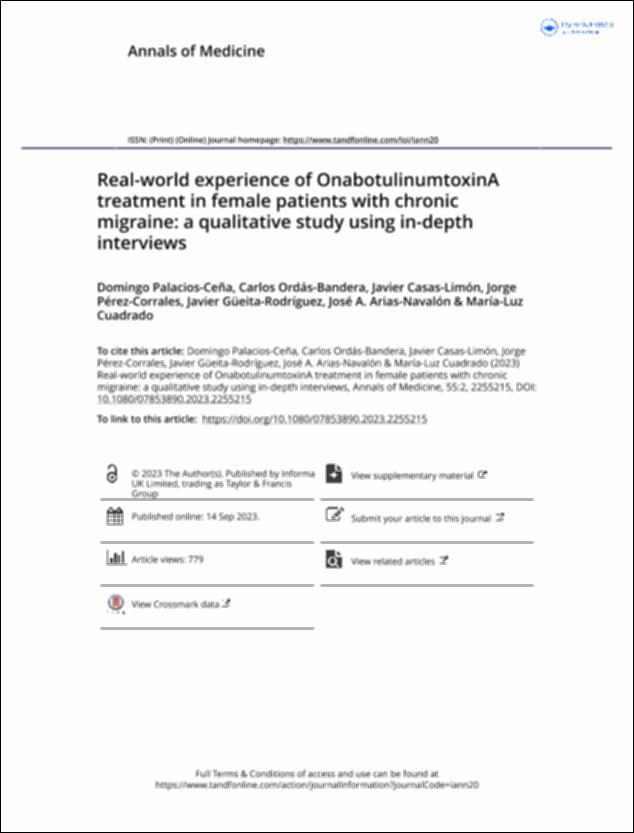Please use this identifier to cite or link to this item:
http://hdl.handle.net/10637/15271Real-world experience of OnabotulinumtoxinA treatment in female patients with chronic migraine: a qualitative study using in-depth interviews
| Title: | Real-world experience of OnabotulinumtoxinA treatment in female patients with chronic migraine: a qualitative study using in-depth interviews |
| Authors : | Palacios Ceña, Domingo Ordás Bandera, Carlos Casas Limón, Javier Pérez Corrales, Jorge Güeita Rodríguez, Javier Arias Navalón, José Antonio Cuadrado, María Luz |
| Keywords: | (MeSH); Botulinum toxin type A; Drug therapy; Migraine disorders; Women; Qualitative research |
| Publisher: | Taylor and Francis Group |
| Citation: | Domingo Palacios-Ceña, Carlos Ordás-Bandera, Javier Casas-Limón, Jorge Pérez-Corrales, Javier Güeita-Rodríguez, José A. Arias-Navalón & María-Luz Cuadrado (2023) Real-world experience of OnabotulinumtoxinA treatment in female patients with chronic migraine: a qualitative study using in-depth interviews, Annals of Medicine, 55:2, 2255215, DOI: 10.1080/07853890.2023.2255215 |
| Abstract: | Five themes were identified: (a) A long way to go before Botox®, (b) First time hearing about the treatment and its expectations, (c) The administration of Botox®, (d) Treatment effects, and (e) Follow-up. Patients described a long history of treatment failures prior to the start of OBT-A treatment. Information about this migraine treatment came from the neurologist; following the information, patients had high expectations, including unrealistic expectations regarding the onset and duration of effect. They acknowledged fear of the injections and some discomfort due to the procedure. With treatment, participants reported better migraine control and an improvement in their quality of life. Follow-up had some barriers, such as delayed appointments for subsequent doses, but also strengths, such as effectiveness and few side effects. Conclusions: Qualitative research offers insight into how patients with CM experience treatment with OBT-A. Our results highlight some relevant aspects that should be considered when providing OBT-A treatment. |
| URI: | http://hdl.handle.net/10637/15271 |
| Rights : | http://creativecommons.org/licenses/by/4.0/deed.es OpenAccess |
| ISSN: | 1365-2060 |
| Issue Date: | 14-Sep-2023 |
| Center : | Universidad San Pablo-CEU |
| Appears in Collections: | Medicina |
Items in DSpace are protected by copyright, with all rights reserved, unless otherwise indicated.


